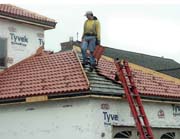
Like any niche market, the roof tile segment can offer a contractor significant advantages - an exclusive position in your regional market and challenging work that can offer great rewards.
Now for the trade off: Like any niche market, success in the roof tile segment requires extra commitment in the form of product education, training and an understanding of the unique needs of this high-end customer base.
Many trends are causing the tile industry to become more complex, requiring an even bigger commitment on the part of installers. Manufacturers have recognized this and have been working through the Roof Tile Institute (RTI) to provide consumers and contractors with tools to help ensure tile, from product to installation, lives up to homeowner expectations.
First, an overview of some of the trends causing change in the roof tile segment.

Architectural Trends
Traditionally, tiles were installed on flat roof planes, whether the slope was 12:12 or 4:12. But today we're seeing roofline complexities such as multiple roof slopes on the same structure, complicated use of hips and valleys, and designs that are much more cut up than traditional roofing. Manufacturers have been designing roof systems differently to accommodate the different architectural features that are becoming more common in this high-end segment of the market - the eyebrow dormers, turrets and sweeping curved roof sections. This complexity makes for a much more difficult installation that may require additional flashings, underlayment or ventilation expertise.Evolving Regional Markets
Many tile color and style preferences are still regional but the markets are beginning to change. The rate of change will increase over the next several years for two reasons. First, new product variety will revitalize the saturated markets in the Sunbelt. The curved, high barrel tile in red and orange shades have become commonplace. But now we are seeing more interest in variety of both tile style and tile color. Homeowners and architects are more open to new options - anything other than standard, rounded tiles in reds and oranges.In addition to the wide variety of colors available, multicolor installations are gaining interest in many areas of the country. For example, installations that blend four colors, using 25 percent of each on a roof, are an easy adjustment that creates more variety. For additional customization, tile colors can also be sequenced or marbled during production. Changing the way you batch color combinations, or using tiles with different sealers and glazings, an endless variety of options are available.
Second, as roof tile expands into new markets like the Midwest or the mountain states, installers will have to continue to expand their skills to accommodate steeper slopes and severe weather. Tile can meet all of these requirements but, of course, the installation may require special underlayments, additional ventilation, snow retention or other modifications.
Lightweight Products
To meet the needs of contractors and installers, manufacturers are looking for ways to make their tile designs stronger while using less material. Lightweight tile can help contractors save costs by reducing structural requirements compared to using standard weight tile. A limited number of quality lightweight tile are now available and more are on the horizon. Research and development has lead to better products than those previously on the market. In addition to reducing freight costs, lightweight tile is easier to work with. Contractors should also be able to benefit from labor savings by using lightweight tiles that take less time and equipment to install. However, lightweight tile lines do not offer the variety that is available with concrete tile.Lifecycle Costing
Roof tile will never be appropriate for the sector of the housing market looking for the biggest house for the cheapest cost per square foot. But the segment of the high-end roof market that is a fit for roof tile is becoming more aware of lifecycle costing, and is looking at a roof investment from a long-term perspective. These are the homeowners who have accumulated wealth over years by making smart decisions and understand the lifecycle perspective. It's this customer who understands the trade-off when the initial roof investment costs up to three times more than standard alternatives but it's going to last up to five times longer. The entire industry, from manufacturer to installer, has a role in educating the consumer on this topic.Environment and Energy Concerns
Like other segments of the roofing industry, environmental concerns - including energy saving alternatives - are impacting the tile roof segment. We're seeing more requests for pure white tile for improved energy efficiency, especially in Florida. Ten years ago it was rare to receive this kind of order. The interest is supported by new product developments including additives and sealers to maintain mold- and algae-resistance and retain the white color.
Installation techniques that enhance energy efficiency are feeding into this trend as well. Rather than nailing tile directly to the deck, installers can use battens and counter-battens to raise the tile off the deck and allow for better air flow. This serves the dual purpose of ice damming control in severe winter areas and heat control in the Sunbelt. This trend will continue to play an evolving role in tile development and installation techniques over the next decade.
Installer Outreach
With all of these trends driving change in the market, manufacturers have recognized the need to make changes as well. Individually and through the RTI, we have been making an effort to shorten the learning curve for new installers and streamline processes for current installers.In a coordinated effort through RTI, manufacturers collaborated on the first industry-based installation manual in 2002. The Installation Manual for Moderate Climate Regions (available at www.rooftile.org) provided uniform criteria for installers. This was the first step in a series of outreach materials the RTI is coordinating. Similar manuals for severe weather, high wind and seismic areas are currently available and are being updated to meet new code standards.
In addition, the RTI is in the process of qualifying minimum standards for support materials such as underlayments, flashings, battens, etc. This effort hits close to home for me. I have always been a believer in providing installers with a complete package - not just tile but also all support materials. When we ship an order from Vande Hey Raleigh, each component of the entire roof system is labeled to match a corresponding roof plan. Technical support during design and installation is also available. This streamlines the entire installation process and I have firsthand experience with the benefits for everyone involved.
In 2004, the RTI will take its outreach program one step further and introduce a formal Moderate Climate Installation Training Program to meet the requirements of the manual. I would encourage contractors interested in tile installation to take advantage of training available from the manufacturer or stay in touch with the efforts of the RTI. As the niche continues to evolve, RTI will continue to help installers stay out front of the trends.
Report Abusive Comment